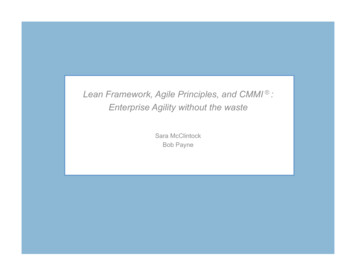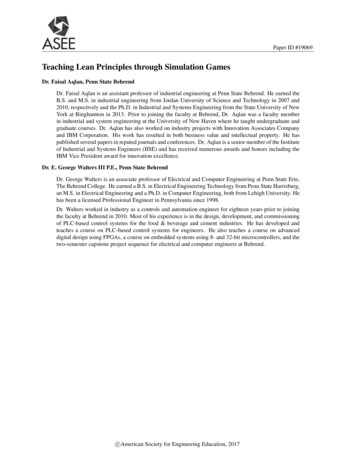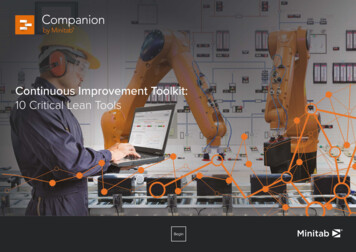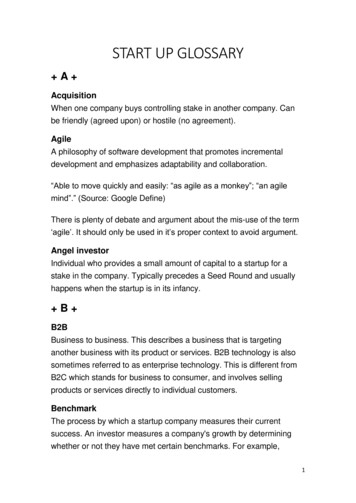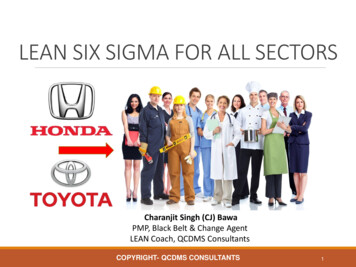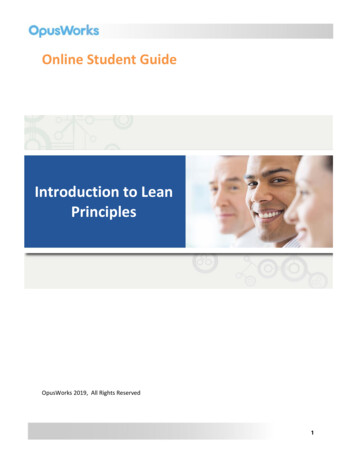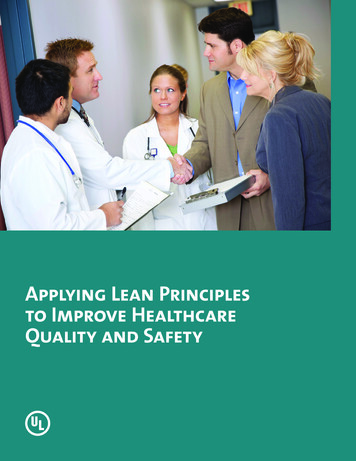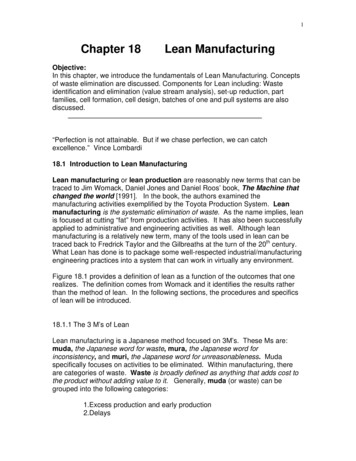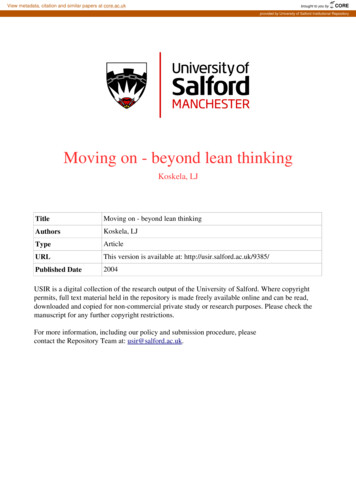
Transcription
View metadata, citation and similar papers at core.ac.ukbrought to you byCOREprovided by University of Salford Institutional RepositoryMoving on beyond lean thinkingKoskela, LJTitleMoving on beyond lean thinkingAuthorsKoskela, LJTypeArticleURLThis version is available at: http://usir.salford.ac.uk/9385/Published Date2004USIR is a digital collection of the research output of the University of Salford. Where copyrightpermits, full text material held in the repository is made freely available online and can be read,downloaded and copied for non commercial private study or research purposes. Please check themanuscript for any further copyright restrictions.For more information, including our policy and submission procedure, pleasecontact the Repository Team at: usir@salford.ac.uk.
Moving-on — beyond lean thinkingLauri Koskela1AbstractLean Thinking is currently often positioned as the underlying theory of lean productionamong practitioners and academics, although its originators, Womack and Jones, seem notto have presented it as a theory. This paper endeavours to analyze whether Lean Thinkingcan be viewed as a theory of lean production.For this purpose, a critical assessment of Lean Thinking is carried out. Lean Thinking isargued to lack an adequate conceptualization of production, which has led to impreciseconcepts, such as the term “value”. The five principles of Lean Thinking do notsystematically cover value generation, and they do not always encapsulate the core topicsin their respective areas. The failure to trace the origin of lean concepts and principlesreduces the opportunity to justify and explain them.Despite claims for generality, the application area of the five lean principles is limited tothe transformation of mass production, with, for instance, one-of-a-kind production andconstruction being largely out of scope. It is concluded that it is opportune to move onbeyond Lean Thinking, towards a generic theory of production, for acquiring a solidfoundation for designing, operating and improving production systems.Keywords: Lean thinking, theory, productionIntroduction“Lean production is ‘lean’ because it uses less of everything compared withmass production: half the human effort in the factory, half the manufacturingspace, half the investments in tools, half the engineering hours to develop anew product in half the time.”This characterization of lean production, as presented in the book The machine thatchanged the world by Womack, Jones and Roos (1990), captured the attention ofproduction practitioners and researchers worldwide. The description of lean production byWomack and his co-authors has proved to be a highly useful synthesis of advancedmanufacturing practices, first developed at Toyota and later adopted by other carmanufacturers. The very term “lean production” has become widely used for referring to aspecific template and practice of production, also well known as the Toyota ProductionSystem.1The University of Salford, School of Construction & Property Management, Salford M7 1NU, United Kingdom.E-mail: l.j.koskela@salford.ac.uk Lean Construction Journal 2004Vol 1 #1 October 200424www.leanconstructionjournal.org
Koskela: Moving-on — Beyond lean thinkingIt is in this spirit that the founders of the International Group for Lean Construction startedto use (or maybe coined, instances of prior usage are not known to the author) the term“lean construction” in 1993, for referring to a mode and practice of construction inspiredby the Toyota Production System.As is well-known, research, development andimplementation of lean construction has since then advanced and diffused to allcontinents.However, since the late 1990’s, a subtle, but significant problem with the terms “leanproduction” and “lean construction” has emerged. It has become evident that many peopledo not associate these terms with evolutionary production templates developed or inspiredby Toyota, but rather with the application of “lean thinking”, and especially the fiveprinciples of Lean Thinking2 as presented by Womack and Jones (1996). Unfortunately,these five principles are a stark and to some extent imprecise simplification of theunderlying theoretical framework of the Toyota Production System. The principles haveexcellently served a pedagogical and marketing function, but real life implementation, aswell as further development of lean must – and can — be based on a wider set of ideas andframeworks. Thus, this paper argues that we have to move on, beyond this Lean Thinkingoriented understanding of lean production.The paper is structured as follows. At the outset, the origins and popular interpretation ofLean Thinking are analyzed. Next, the question whether Lean Thinking can be seen a theoryin general is dealt with. Based on this consideration, Lean Thinking is then analyzedregarding conceptualization, validity of its principles, justification and range ofapplicability. Finally, conclusions are drawn from the preceding analyses.Lean thinkingOriginAs admitted later by two of its authors (Womack and Jones 1996), the book The machinethat changed the world did not concisely summarize the principles of lean production. Intheir newer book (1996), Womack and Jones endeavour to improve the theoretical side ofthe discussion of lean production. They say of the previous book: “ the thought processneeded to tie all the methods together into a complete system was left largely implicit.”Further: “ we realized that we needed to concisely summarize the principles of “leanthinking” to provide a sort of North Star, a dependable guide for action for managersstriving to transcend the day-to-day chaos of mass production.” Without such a guide,managers are drowning in techniques “without understanding the whole.”Consequently, Womack and Jones (1996) summarize the principles underpinning LeanThinking:1.Precisely specify value by specific product.2.Identify value stream for each product.3.Make value flow without interruptions.4.Let the customer pull value from the producer.2In this presentation, Lean Thinking refers to the particular type of lean thinking proposed by Womack andJones (1996) in their book with the same title. For clarity, the book title is written here in italics: LeanThinking. Lean Construction Journal 2004Vol 1 #1 October 200425www.leanconstructionjournal.org
Koskela: Moving-on — Beyond lean thinking5.Pursue perfection.As it is well known, the book Lean Thinking has been hugely successful, and this success hasled to conferences and a community around the topic of Lean Thinking.InterpretationLean Thinking is clearly a business book. To the best knowledge of the writer, its authorshave never presented and justified the five principles of Lean Thinking as a theory3 in anyacademic journal. However, it seems that the very success of the book has led to misplacedviews on Lean Thinking. It has been understood that the five principles provide anexhaustive, mature foundation – equivalent to a theory — for the transformation of anyproductive activity. For example, the Egan report (Rethinking construction 1998) stated:“Lean Production is the generic version of the Toyota Production System, recognized asthe most efficient system in the world today. Lean Thinking describes the coreprinciples underlying this system that can also be applied to every other businessactivity – from designing new products and working with suppliers to processing ordersfrom customers.”A similar view has recently been taken in operations management (OM) literature (Slack,Lewis & Bates 2004):“For instance, JIT/lean production is a long-established OM research priority that inrecent years has probably become less prominent as a subject as the core principleshave matured. In terms of practice however, there is still a great deal of scope forapplying these, now clearly articulated and tested, principles – especially beyond theirtraditional manufacturing roots (e.g. Womack and Jones, 1994, 1996)”.Similarly, Hines et al. (2004), while acknowledging the evolutionary nature of leanproduction, nevertheless claim that the principles have remained unchanged:“Such a process of evolution has maintained the adherence to the lean principlesdeveloped by Womack and Jones (1996) but has explored different applications andcontingencies faced by organizations during the adaptation process.”Are the five principles of Lean Thinking valid as a theoretical foundation, in the way theyseem to be understood in many circles? This question is not only academic but also highlypractical. Namely, from an academic point of view, if this is the general theory, we canreduce our efforts to understand lean production, and we can concentrate on the issues ofimplementation. And from the practical viewpoint, we can fully trust that by using thistheory, we can transform any line of production or service into a lean operation.Is lean thinking a theory?Theory is a slippery concept, with many connotations. In one sense, theory refers togeneral principles of any field or discipline. In this sense of the term, the question is surelyabout theory, and the assessment reduces to assessing the adequacy of the principles3It is true that Womack and Jones (2003) write in the Afterword: “Our problem in writing this book wasnever theory. Authors with academic backgrounds will generally have no trouble spinning theories, and thistask happily occupied us during the first year of this project (1992-93). But then we needed proof that ourtheorizing actually works, examples of real managers in real firms who are succeeding by employing ideassimilar to ours”. However, a close reading of this passage reveals that the authors do not claim to presenttheir theorizing in the book in a systematic manner. Lean Construction Journal 2004Vol 1 #1 October 200426www.leanconstructionjournal.org
Koskela: Moving-on — Beyond lean thinkinginvolved – this will be carried out below. However, in the more stringent sense of the term,a theory refers to a scientific theory. According to Whetten (1989) such a theory willcontain four essential elements: What. Which factors (variables, constructs, and concepts) logically should beconsidered as part of the explanation of the phenomena of interest? How. How are factors related? Here, causality is introduced. Why. What is the rationale that justifies the selection of factors and theproposed causal relationships? An explanation is required. Who, Where, When. The boundaries of generalisability and thus the range ofthe theory have to be set.Is Lean Thinking a scientific theory? Does it have the parts as suggested by Whetten?Lean Thinking contains five principles, which at least implicitly present causalrelationships: do this, so waste is minimized and value maximized. It thus contains the“How” element. However, other parts are either lacking or treated in a shallow or partialmode. There is no conceptualization of lean production, i.e. an answer to the “What”question. There is some justification for the principles, but not for the whole approach.Thus, the “Why” question has not been systematically answered. The “Who, where, when”issue is not tackled in any deeper sense, although one gets the impression that theprinciples are suggested to be generally usable.Surely theories may be usable and widely diffused without being perfect in Whetten’s(1989) sense. He comments that the last element, the boundaries of the theory, is oftenthe least developed area. Thus, the question is whether the failure to adequately presentthe “What”, “Why” and “Who, where, when” elements creates detrimental impacts.Thus, Lean Thinking contains at least some elements of a theory, and these can beevaluated in the normal way by assessing their validity in comparison to empirical reality.However, regarding the missing or in some respect inadequate elements, we ask: In whichway are we in a poorer position without those elements?In the following section we start by inspecting the conceptualization of production(“What”). Then, we proceed to the evaluation of the lean principles (“How”). The way oftackling the “Why” issue is by looking at the historical development process, leading to theintroduction of concepts and causalities in question. Lastly, we analyze Lean Thinking fromthe “Who, where, when” point of view.Conceptualization of productionConcepts of productionThe reader of Lean Thinking cannot avoid noticing that there are two central, allegedlynew terms for analyzing production: muda (the word waste in Japanese) and value.However, it is not explained from where these terms originate.In our view, these terms naturally flow from the concepts of production relied on. Even ifthere has been very little explicit research into theories of production, we can find threetheoretical models of production (Koskela 2000). The most common view has been that Lean Construction Journal 2004Vol 1 #1 October 200427www.leanconstructionjournal.org
Koskela: Moving-on — Beyond lean thinkingproduction is a transformation of production factors into the product. Another view is thatproduction is a flow of material through the production system. The third view is thatproduction is value generation, fulfilling the customers' needs and wishes.The splendid feature of the transformation model is simplicity: it focuses just on what goesin and what goes out of production. Of course, productivity is a related term, beingdetermined by input and output. Here, the first principle is to decompose the totaltransformation into smaller ones, usually called tasks, and to perform each of them in anoptimal manner. Isn't this reasonable: we look at what has to be done, we do all that andproduction is completed? The crucial assumption here is the independence of these tasks.If it is evident that they are not independent, we can make them (relatively) independentby buffering them.In the flow model, we introduce time as an attribute. When we look what happens to apiece of material in production, we observe that there are transformations, but alsowaiting, inspection and moving stages. The last three are not really needed fortransformation, and they can be called waste. The first principle is to eliminate or reducethis waste. How can it be done? Already from the twenties it has been known that timecompression leads to waste reduction (Koskela 2000, 68-9). A newer insight is thatuncertainty (to be precise, variability, that is, random variation in the processing times orarrival of inputs) is an important cause of waste.In the value generation model, the customer is introduced. The first principle is to createthe best value for the customer. The pedigree of the value generation model goes back toShewhart (1931), who defined two further principles of value generation at the outset ofthe quality movement:Looked at broadly there are at a given time certain human wants to be fulfilledthrough the fabrication of raw materials into finished products of differentkinds. [ ]The first step of the engineer in trying to satisfy these wants is therefore thatof translating as nearly as possible these wants into the physical characteristicsof the thing manufactured to satisfy these wants. [ ]The second step of the engineer is to set up ways and means of obtaining aproduct which will differ from the arbitrarily set standards for these qualitycharacteristics by no more than may be left to chance.There are two important insights here. First, it makes a difference which concept ofproduction is used: depending on what basic concept you select, you end up with verydifferent, even conflicting, prescriptions for production. For example, the transformationmodel suggests using buffers between workstations; the flow model suggests eliminatingbuffers. Second, terms such as ‘productivity’, ‘waste’ and ‘value’ are not independent,self-contained concepts – rather they are embedded in different conceptualizations ofproduction, which provide their meaning.Unfortunately, the conceptualization of production, i.e. an answer to the “What” question,is conspicuously lacking from Lean Thinking. Some of the problems caused are explorednext. Lean Construction Journal 2004Vol 1 #1 October 200428www.leanconstructionjournal.org
Koskela: Moving-on — Beyond lean thinkingThe relationship of waste and valueWomack and Jones write: “Lean thinking also provides a way to make work more satisfyingby providing immediate feedback on efforts to convert muda into value.” This suggests thatvalue can be maximized through minimizing waste. Indeed, they define the eighth waste asdesign of goods and services that do not meet users’ needs (the first seven wastes beingthose defined by the Japanese originators of the Toyota Production System).However, these two concepts, waste and value, are better thought of as existing indifferent, even if intersecting dimensions. A product with a wonderful value may beproduced in a most wasteful process. On the other hand, a product with a clearly deficientvalue may be produced in a most waste-free process. Unfortunately, there is no such handyand direct connection between waste and value as indicated in Lean Thinking.What is value?Womack and Jones state: “The critical starting point for lean thinking is value. Value canonly be defined by the ultimate customer.” This is a sensible characterization of value,which connects to more general use of the term.However, when we start to inspect the lean principles, we readily realize that something isnot in order (Table 1). Regarding the first principle: How can we specify value, if it issomething happening between the customer and the product? We cannot. Obviously, valueis used instead of the word product (or perhaps product features or functions) there. Thenvalue is flowing in the value stream, and value is pulled at the end. Have we ever seenvalue flowing or being pulled in factories? No, we see only parts, materials and completedproducts. Obviously, in turn, value is here used to mean materials, parts or products.Table 1: The many meanings of value in the lean principlesLean principlesInferred meaning of value1. Precisely specify value by specificproduct.1. Specify2. Identify valueproduct.stream2. Valuestream information) flow3. Makevalueinterruptions.flowforeachwithout4. Let the customer pull value from theproducer.3. Valuevalue specifyparts,productmaterial(ormaterials4. Value product5. Pursue perfection.Now we are able to decipher the significance of the statement “ the thought processneeded to tie all the methods together into a complete system was left largely implicit”(Womack & Jones 1996). Without an explicit theory of production as value generation, theyjust use the term value as glue that artificially keeps the principles together, indeed tiesthem together into a complete system. In doing so, they have to stretch the meaning ofvalue excessively and misleadingly wide. Unfortunately, the frequent use of ‘value’ amongthe principles also conceals the fact that very little is said on how to maximize value. Lean Construction Journal 2004Vol 1 #1 October 200429www.leanconstructionjournal.org
Koskela: Moving-on — Beyond lean thinkingSimply, the authors are using imprecise and unsystematic terms, due to lack of explicitconceptualization.Assessing the principles of lean thinkingThe following questions are posed for assessing the principles: What is meant by theprinciple? Does the principle encapsulate what we know about its theme area?Precisely specify value by specific productWhat is meant by the principle?The central message of this principle seems to be to “rethink value from the perspective ofthe customer” and “to ignore existing assets and technologies”.Does it encapsulate what we know?That value should be rethought from the point of view of the customer is now a somewhattired platitude (we return to this below). Instead, already Shewhart succeeded in definingtwo high-level principles of value generation, and there are candidates for three others(Koskela 2000). Unfortunately, none of these is treated as Lean Thinking4. But is thisjudgement premature, noting that value is explicitly mentioned in three subsequentprinciples? Unfortunately, “value” in the subsequent principles is a misnomer, as justifiedabove. The first principle is the only one trying to cover value generation, but whether itdoes the job, is questionable.Identify value stream for each productWhat is meant by the principle?The question is about the modelling and designing of the production system, includingproduct development, order fulfilment and the production proper, especially with the goalof weeding out avoidable wasteful activities.Does it encapsulate what we know?At a high level of abstraction, this principle works reasonably well5.Make value flow without interruptionsWhat is meant by the principle?This principle, while addressing generally the reduction of lead times, refers primarily tothe method of one-piece flow, instead of a flow consisting of batches.4This is understandable taking into account that value issues have historically been somewhat outside theToyota Production System. Cell and Arratia (2003) state from a value engineering (VE) viewpoint: “UnlikeVE, Lean has no analytical or methodological mechanism for analyzing the design of the product with theintent of reducing production cost or otherwise increasing customer value”.5Of course, it is not very explicit with the criteria of designing production systems, but this is due to a widerlack of understanding in this regard. Lean Construction Journal 2004Vol 1 #1 October 200430www.leanconstructionjournal.org
Koskela: Moving-on — Beyond lean thinkingDoes it encapsulate what we know?Actually, there are several other conclusions from this principle than one-piece flow – theyseem not to be treated. It can easily be shown through queuing theory that variabilityincreases the lead time (Krupka 1992, Hopp & Spearman 1996) and thus work-in-progress.Thus, reduction of variability can be used as one important method of waste elimination.However, variability is not covered in Lean Thinking.Let the customer pull value from the producerWhat is meant by the principle?According to the principle, the customer is pulling the product from the production systemas needed rather than the production system pushing products, often unwanted, onto thecustomer.Does it encapsulate what we know?Push systems schedule the release of work, while pull systems authorize the release ofwork on the basis of system status (Hopp & Spearman 1996). The underlying feature of thepull systems, like kanban, is that they establish a cap for work-in-progress, which will alsokeep lead-time in control.A production control system can also be a mixed push-pull system. Huang and Kusiak(1998) present a push-pull system that pushes through certain manufacturing stages andpulls elsewhere based on the characteristics of these stages. They argue that this issuperior to a push system, while avoiding some inherent problems of pull systems. Thus,either push and pull method may be appropriate depending on the characteristics of theproduction stage in question. Accordingly, the wording of this principle is too categorical.Pursue perfectionWhat is meant by the principle?Womak and Jones say, “there is no end to the process of reducing effort, cost, andmistakes while offering a product which is ever more nearly what the customer actuallywants” (1996). Obviously, the question is about continuous minimization of waste andmaximization of value, i.e. continuous improvement.Does it encapsulate what we know?The principle is defined on a very general level. The book rightly mentions transparency asone of the most important spurs to perfection. Unfortunately, the role of standards(Nakamura 1993) is not treated in connection to continuous improvement. Neither is thescientific experimentation model of Shewhart mentioned (to be discussed below).Assessment of the principles as a wholeWomack and Jones (1996) write: “By clearly understanding these principles, and then tyingthem together, managers can make full use of lean techniques and maintain a steadycourse.” Lean Construction Journal 2004Vol 1 #1 October 200431www.leanconstructionjournal.org
Koskela: Moving-on — Beyond lean thinkingUnfortunately, there are problems here. Indeed, the authors cover a number of crucialprinciples or practices related to the flow concept; the treatment is selective, however,and several key issues are left out6. Moreover, the value generation concept principles areleft almost without mentioning. How the transformation concept is used in lean productionis not discussed at all.A related problem is that there is a gap between the first principle, addressing productspecification, and the following three principles, addressing, in practice, production. It isto be assumed that product development has somehow been completed between the firstand second principle.All in all, it is highly questionable whether all principles, in their starkly compressed form,can be understood in a productive way and whether they come together to a whole.Justification of the lean principlesWhy should we think that just these principles should be adopted? In principle, several waysof justification can be used. However, if the question is about an existing idea or practice,a natural way is to seek for a justification from the situation where the breakthrough of theidea or practice happened. So, the question, from where do the principles originate andwhat was the related rationale, poses itself.Specify valueThe first principle, in the meaning “rethink value from the perspective of the customer”and “to ignore existing assets and technologies” is well known in the American marketingliterature. In 1960, Levitt attacked the then prevailing production paradigm:Mass-production industries are impelled by a great drive to produce all theycan. The prospect of steeply declining unit costs as output rises is more thanmost companies can usually resist. The profit possibilities look spectacular. Alleffort focuses on production. The result is that marketing gets neglected.The difference between marketing and selling is more than semantic. Sellingfocuses on the needs of the seller, marketing on the needs of the buyer. Sellingis preoccupied with the seller’s need to convert his product into cash,marketing with the idea of satisfying the needs of the customer by means of theproduct and the whole cluster of things associated with creating, delivering andfinally consuming it. a truly marketing-minded firm tries to create value-satisfying goods andservices that consumers want to buy.6One may ask whether it is possible, in general, to condense lean production into five principles. Incomparison, Schonberger (1996) presents sixteen principles for world class manufacturing, which seem tolargely cover the area of the five lean principles but go beyond them. On the other hand, there are areas,such as the value stream mapping, where lean principles seem to present new insights in comparison toSchonberger’s treatment. Lean Construction Journal 2004Vol 1 #1 October 200432www.leanconstructionjournal.org
Koskela: Moving-on — Beyond lean thinkingOf course, Levitt’s views are fully compatible with Shewhart’s value generation model,explained above. There is nothing wrong in reminding people of these often neglectedideas, even if they have not figured prominently in the framework of the Toyota ProductionSystem. However, many a reader of Lean Thinking might have benefited from connectingthis idea to its roots and related previous discussions.Value stream, flow and pullThe three middle principles can be discussed together, as they all are original features ofthe Toyota Production System, discussed in the books of Ohno and Shingo as well as in thefirst Western interpretations (for example, Schonberger 1982).The origin of the second principle might be in the flow oriented principles for designing thefactory layout. In addition, this is an area where the re-engineering movement operatedduring its heyday. It must be added that the idea of modelling production processes haseven deeper roots. Frank and Lillian Gilbreth (1922), in a paper advocating processmodelling, refer to practices that obviously resemble value stream mapping:In many instances recording industrial processes in process-chart form hasresulted in astonishing improvements.Similarly, the third principle, focusing on one-piece flow, is one of the issues addressedearly by the Japanese originators. The fourth principle on pulling seems to derive from thekanban production control, an original invention of the Toyota Production System.Again here, the discussion and justification of these principles would have had more depthif the roots had been covered.PerfectionThe fifth principle addresses continuous improvement. In the West, continuousimprovement, associated both with JIT and TQC, emerged as a theme in itself especiallyafter the book by Imai (1986). A key idea is to maintain and improve the working standardsthrough small, gradual improvements. The inherent wastes in the process are naturaltargets for continuous improvement. However, even in this case there is an importantpredecessor. Shewhart (1931) presented the idea of the scientific experimentation model,which has functioned as the basis of the introduction of continuous improvement in totalquality management, and still can be recognized as a backbone in the current Japaneseimplementation of the Toyota Production System, as described by Spear and Bowen (1999).Unfortunately, without presenting the seminal idea of Shewhart on continuousimprovement, only the superficial appearance of continuous improvement is conveyed andshallow justification of it is provided to the reader.Range of applicabilityWomack and Jones (1996) write: “As the examples will show, we know how to apply leanthinking, techniques and organization to practically any activity, whether a go
Moving-on — beyond lean thinking Lauri Koskela1 Abstract Lean Thinking is currently often positioned as the underlying theory of lean production among practitioners and academics, although its originators, Womack and Jones, seem not to have presented it as a theory. This paper end
